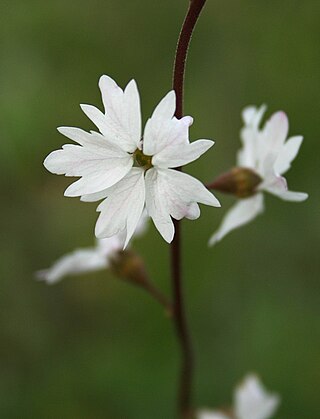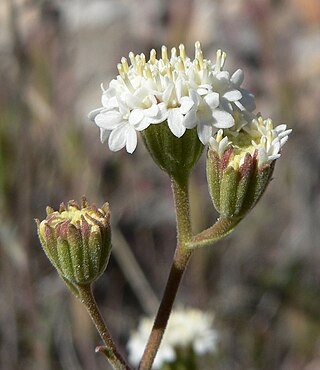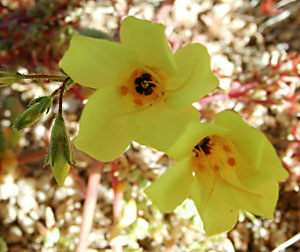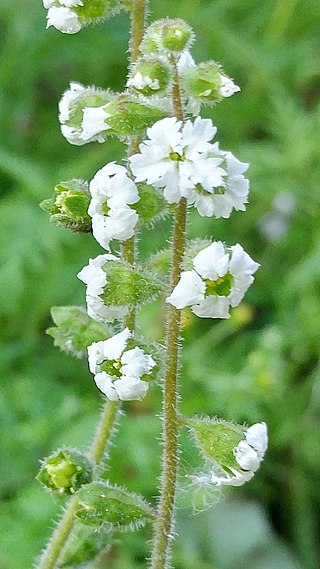
Lithophragma is a genus of flowering plants in the saxifrage family containing about nine species native to western North America. These plants are known generally as woodland stars. The petals of the flowers are usually bright white with deep, long lobes or teeth. Each petal may look like three to five petals, when at closer inspection the lobes fuse into a single petal at its base. Most species reproduce via bulblets instead of seeds. L. maximum is a federally listed endangered species. Lithophragma specifically coevolved with moths of the genus Greya, who pollinate and only lay eggs on Lithophragma plants.

Enemion occidentale is a species of flowering plant in the buttercup family known by the common name western false rue anemone. It is found in California and rarely in Oregon where it is a resident of forest, woodland, and chaparral habitats in many of the mountain ranges. This is a small perennial herb producing one or more erect, unbranched stems growing to maximum heights near 25 centimeters. Leaves appear toward the top of the smooth, naked stems. Each green cloverlike leaf is divided into usually three irregular lobes. The solitary flowers are petite with white to very light lavender petallike sepals and no petals. At the center are white stamens with yellow anthers and white styles with yellow stigmas.

Chaenactis stevioides, with the common names Esteve's pincushion and desert pincushion, is a species of flowering plant in the daisy family. It is also sometimes called false yarrow or broad-leaved Chaenactis.

Leptosiphon aureus is a species of flowering plant in the phlox family known by the common name golden linanthus.

Leptosiphon grandiflorus is a species of flowering plant in the phlox family known by the common names large-flower linanthus and large flowered leptosiphon.

Leptosiphon montanus is a species of flowering plant in the phlox family known by the common name mustang clover.
Leptosiphon nudatus is a species of flowering plant in the phlox family known by the common name Tehachapi linanthus.

Leptosiphon pachyphyllus is a species of flowering plant in the phlox family, known by the common name Sierra linanthus.
Lithophragma bolanderi is a species of flowering plant in the saxifrage family known by the common name Bolander's woodland star. It is endemic to California, where it is known from several mountain ranges, including the North Coast Ranges, the foothills of the Sierra Nevada, and the San Gabriel Mountains. It grows in many types of open habitat. It is a rhizomatous perennial herb growing erect or leaning with a tall naked flowering stem. The leaves are located on the lower part of the stem, each divided into rounded lobes. The stem bears up to 25 flowers, each in a cuplike calyx of red or green sepals. The five petals are white, under one centimeter long, and toothed or smooth along the edges.
Lithophragma campanulatum is a species of flowering plant in the saxifrage family known by the common name Siskiyou Mountain woodland star. It is native to southern Oregon and northern California, where it grows in the forests and woods of the mountains. It is a rhizomatous perennial herb growing erect or leaning with a tall naked flowering stem. The leaves are mostly located on the lower part of the stem, each divided into rounded lobes, sometimes narrowed into teeth. The stem bears 2 to 11 flowers, each in a cuplike calyx of red or green sepals. The five petals are white, under one centimeter long, and divided into irregular toothlike lobes.

Lithophragma cymbalaria is a species of flowering plant in the saxifrage family known by the common name mission woodland star.

Lithophragma glabrum is a slender perennial western North American mountain plant in the Saxifrage family (Saxifragaceae), known by the common names bulbous woodland star, bulbiferous prairie-star, smooth woodland star, and smooth rockstar.

Lithophragma heterophyllum, commonly known as hillside woodland star, is a species of flowering plant in the saxifrage family found in the western United States. It is native to the coastal mountain ranges of California, where it can generally be found in shady habitat. It is a rhizomatous perennial herb growing erect or leaning with a slender naked flowering stem. The leaves are located on the lower part of the stem, each divided into rounded lobes. The stem bears 3 to 12 flowers, each in a cuplike calyx of red or green sepals. The five petals are white, up to 1.2 centimeters long, and usually divided into about three pointed lobes.

Lithophragma maximum, known by the common name San Clemente Island woodland star, is a rare species of flowering plant in the saxifrage family. It is endemic to San Clemente Island, one of the eight Channel Islands of California. It is known from only about four kilometers of rocky coastal cliffs on the edge of the island. The plant was thought to be extinct until a few specimens were rediscovered in 1979. Only 200 individuals were tallied in a 1996 survey. In 1997 the plant was listed as an endangered species on the federal level.

Lithophragma parviflorum is a species of flowering plant in the saxifrage family known by the common name smallflower woodland star. It is native to much of western North America from British Columbia to California to South Dakota and Nebraska, where it grows in several types of open habitat. It is a rhizomatous perennial herb growing erect or leaning with a naked flowering stem. The leaves are mainly located low on the stem, each cut into three lobes or divided into three lobed leaflets. The stem bears up to 14 flowers, each in a cuplike calyx of red or green sepals. The five petals are bright white, up to 1.6 centimeters long, and usually divided into three toothlike lobes.

Lithophragma tenellum is a species of flowering plant in the saxifrage family known by the common name slender woodland star.

Mentzelia gracilenta, known by the common names blazing star, grass blazingstar, and slender blazing star, is a species of flowering plant in the family Loasaceae.

Ribes inerme is a species of currant known by the common names whitestem gooseberry and white stemmed gooseberry. It is native to western North America from British Columbia to California and eastward to the Rocky Mountains. It grows in mountain forests, woodlands, and meadows.

Packera bolanderi is a species of flowering plant in the aster family known by the common names Bolander's ragwort and seacoast ragwort. It is native to the west coast of the United States from Washington to northern California, where it grows in wet coastal forests and woodlands. There are two varieties of the species which differ slightly in morphology and habitat occupied; these varieties have been considered separate species by some authors. The var. bolanderi has thicker leaves, occurs farther south, and occupies more open types of habitat, than does var. harfordii. This plant in general is a perennial herb producing one to three stems up to half a meter tall. The basal leaves have blades up to 12 centimeters long which are divided into several lobes and borne on long, thin petioles. Leaves growing farther up the stem are smaller and have more lobes on their blades. The inflorescence contains several flower heads, each lined with dark green phyllaries. The head contains many golden yellow disc florets and generally either 8 or 13 yellow ray florets each over a centimeter long. The fruit is an achene tipped with a pappus of bristles.

Packera breweri is a species of flowering plant in the aster family known by the common name Brewer's ragwort. It is endemic to central California, where it occurs in the woodlands and grasslands of the Central Coast Ranges. They are more frequently found in mid-southern counties of California near the coast, such as Kern or Monterey.

















